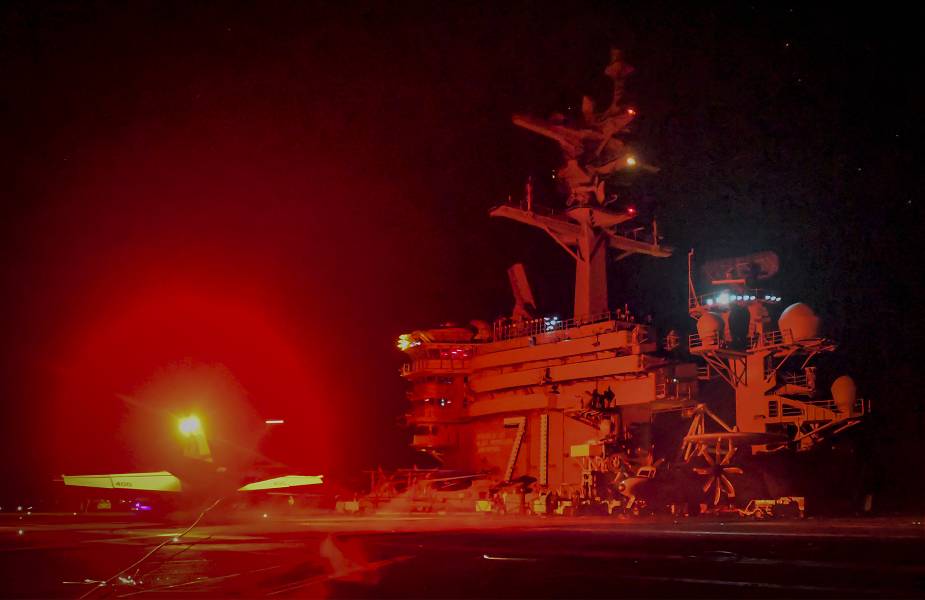Breaking news
US Navy Nimitz-class aircraft carrier USS Theodore Roosevelt completed carrier qualifications.
The US Navy Nimitz-class aircraft carrier USS Theodore Roosevelt (CVN 71) and Carrier Air Wing (CVW) 11 completed carrier qualifications, June 2, 2020. According to information published on the media website of the US Department of Defense.
Follow Navy Recognition on Google News at this link
 Capt. Michael Langbehn, deputy commander of Carrier Air Wing (CVW) 11, makes his 1,000th arresting gear landing while piloting an F/A-18E Super Hornet assigned to the Golden Warriors of Strike Fighter Squadron (VFA) 87 on the flight deck of the aircraft carrier USS Theodore Roosevelt (CVN 71), May 27, 2020. (Picture source U.S. Navy)
Capt. Michael Langbehn, deputy commander of Carrier Air Wing (CVW) 11, makes his 1,000th arresting gear landing while piloting an F/A-18E Super Hornet assigned to the Golden Warriors of Strike Fighter Squadron (VFA) 87 on the flight deck of the aircraft carrier USS Theodore Roosevelt (CVN 71), May 27, 2020. (Picture source U.S. Navy)
During this period, Theodore Roosevelt qualified pilots from the “Tomcatters” of Strike Fighter Squadron (VFA) 31, “Golden Warriors” of VFA-87, “Blue Diamonds” of VFA-146, “Black Knights” of VFA-154, “Liberty Bells” of Airborne Command and Control Squadron (VAW) 115, “The Gray Wolves” of Electronic Attack Squadron (VAQ) 142, and the "Providers" of Fleet Logistics Support Squadron (VRC) 30.
The "Eightballers" of Helicopter Sea Combat Squadron (HSC) 8, and the “Wolf Pack” of Helicopter Maritime Strike Squadron (HSM) 75 also worked with the ship in support of carrier qualification operations.
“It is very gratifying to be able to return to our primary mission in the Indo-Pacific,” said Capt. Steve Jaureguizar, commander, Carrier Air Wing (CVW) 11. “The carrier air wing joined together with the carrier is the bedrock of naval aviation and power projection.”
Carrier qualifications are a time for naval aviators to refine their skills practiced during Field Carrier Landing Practice (FCLP) for sustained operations at sea aboard the aircraft carrier. Carrier qualifications fortified the operational relationship between CVW-11 and Theodore Roosevelt.
Theodore Roosevelt and CVW-11 are on a scheduled deployment to the U.S. 7th Fleet area of operations to provide maritime security, maintain freedom of the seas in accordance with international law and customs, and operate with international partners and allies to promote regional stability and prosperity.
Completing carrier qualification was the last milestone in returning Theodore Roosevelt to sea as a ready, credible naval asset capable of projecting power over the horizon. Theodore Roosevelt is the nation’s fourth Nimitz-class aircraft carrier with a crew of nearly 5,000 Sailors who support and conduct air operations at sea. Theodore Roosevelt departed San Diego for a scheduled Indo-Pacific deployment on January 17.
The USS Theodore Roosevelt (CVN-71) is the fourth Nimitz-class nuclear-powered aircraft carrier in the United States Navy. She is named in honor of Theodore Roosevelt, the 26th President of the United States and a proponent of naval power.
Nimitz-class aircraft carriers are powered by two A4W nuclear reactors, housed in separate compartments. The resulting steam spins four propeller shafts, producing a maximum speed of over 30 knots (56 km/h) and a maximum power of 260,000 brake horsepower (190 MW).[4] The reactors produce heat through nuclear fission which heats water.
In order for a carrier to deploy, it must embark one of ten Carrier Air Wings (CVW). The aircraft carriers can accommodate a maximum of 130 F/A-18 Hornets[32] or 85–90 aircraft of different types, but current numbers are typically 64 aircraft. A typical carrier air wing can include 24–36 F/A-18E or F Super Hornets as strike fighters; two squadrons of 10–12 F/A-18C Hornets, with one of these often provided by the U.S. Marine Corps (VMFA), also as strike fighters; 4–6 EA-18G Growlers for electronic warfare; 4–6 E-2C or D Hawkeyes for airborne early warning (AEW), C-2 Greyhounds used for logistics (to be replaced by MV-22 Ospreys); and a Helicopter Antisubmarine Squadron of 6–8 SH-60F and HH-60H Seahawks.

























